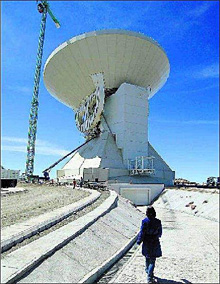 |
 |
 |
 Technology News | April 2007 Technology News | April 2007  
Mexico Takes Pride in Giant Radio Telescope
 Chris Hawley - Arizona Republic Chris Hawley - Arizona Republic


| | The Mexican government says the massive radio telescope atop Sierra Negra is the most ambitious scientific project in Mexico's history. (Chris Hawley/Gannett News Service) |
Sierra Negra, Mexico - It looms over Mexico from a mountain so high it's hard to breathe, a massive white radio telescope of monumental proportions.

Its dish is half the width of a football field, stands as high as a 20-story building and watches the sky from a mountain taller than any peak in the contiguous United States.

The Large Millimeter Telescope is the most ambitious scientific project Mexico has ever undertaken, the government says. It also is part of a growing trend as U.S. and European astronomers search the world for higher, drier sites where they can collect more of the faint signals from space.

Workers are putting the final touches on the telescope after nine years of construction atop the 15,030-foot Sierra Negra. Scientists are testing the instruments and controls and hope to begin research in 2008.

"We're very proud of this telescope," construction worker Ezequiel Galicia Mendoza said, pausing to catch his breath in the thin air. "It's going to push forward science not just in Mexico but in the whole planet. It's got enormous power."

Penetrating cosmic dust

The telescope is part of a new generation of instruments designed to catch radio waves that are only a few millimeters long. That allows it to see through cosmic dust clouds, watch stars form and pick out cooler gases that are invisible to other telescopes.

Two smaller telescopes in Arizona work in this realm, one at Kitt Peak near Sells and one at Mt. Graham near Safford.

But these types of millimeter and submillimeter telescopes are easily blinded by water vapor in the Earth's atmosphere. So the newest ones are built in higher places where the air is thinner: places like Mauna Kea in Hawaii and the Atacama Desert in Chile.

"If you're going to spend millions and millions of dollars on a piece of equipment, you want to make sure it's in the absolute best place possible," said Kevin Marvel, executive officer of the American Astronomical Society.

The Large Millimeter Telescope has cost $131 million so far and is a joint venture between the University of Massachusetts-Amherst and Mexico's National Institute of Astrophysics, Optics and Electronics. About $31 million came from the U.S. Department of Defense, which is interested in radar technology that might emerge from the research.

To build the telescope, workers leveled and drove pylons into Mexico's fourth-largest peak, part of a national park. That highlights another advantage of building in other countries, scientists say: looser rules regarding construction.

When California's Owens Valley Radio Observatory built its own array of millimeter-range telescopes, it was forced to settle for a 7,300-foot-high site instead of the 9,000-foot one it wanted because of opposition from Indian tribes and the U.S. Forest Service, said John Carpenter, the observatory's deputy director.

The hottest site for new telescopes is in Chile's Atacama Desert, 16,598 feet above sea level. An international consortium is building a network of 66 individual telescopes there called the Atacama Large Millimeter/Submillimeter Array.

'Attracting a lot of attention'

While Mexico's telescope will be able to map big swaths of the sky, the Atacama observatory will specialize in close-up pictures.

The Chilean and Mexican telescopes can be linked to create a super telescope so accurate it could pick out a dime on the other side of the Earth.

Planners hope the capability will catapult Mexico into the forefront of astronomy and attract more telescopes to Sierra Negra.

The project has already spurred local companies to develop technology, created a pool of workers skilled in high-altitude construction - the lack of oxygen made it difficult for workers to do their jobs at times - and employed dozens of technicians and graduate students, said Emanuel Mendez, director of construction.

A Mexican-Japanese team has built a detector on Sierra Negra to watch solar flares. A smaller, 15-foot radio telescope is planned for the site, and organizers are considering the mountain for a new gamma-ray telescope.

"This telescope is attracting a lot of attention," said Joaquin Ruiz, dean of the College of Science at the University of Arizona, who also sits on the board of the Mexican astrophysics institute.

"It is a big deal." | 
 | |
 |



